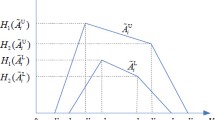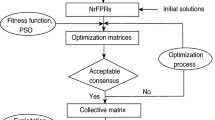Abstract
Natural linguistic terms can preferably express the opinions of decision makers in complicated decision environment. Group decision making with multiplicative trapezoidal fuzzy preference relations transforming from natural linguistic terms attracts the attention of researchers for its important research significant. The developed approach is based on consensus improving process by using a new similarity measure and a trapezoidal fuzzy power ordered weighted geometric averaging (TFPOWGA) operator. In order to introduce this approach, firstly, trapezoidal fuzzy power geometric averaging operator and TFPOWGA operator are presented to aggregate trapezoidal fuzzy numbers (TFNs). Secondly, a new similarity measure for TFNs is introduced by combining centroids and areas of TFNs. We further propose a new consensus improving algorithm that consists of consensus measure and a dynamic feedback mechanism containing a multi-objective optimization model and some indirect rules. And then a selection stage is described to rank the alternatives. At last, an example is implemented to demonstrate effectiveness of the approach.





Similar content being viewed by others
References
Zadeh LA (1965) Fuzzy sets. Inf Control 8(3):338–353
Merigó JM, Gil-Lafuente AM, Yager RR (2015) An overview of fuzzy research with bibliometric indicators. Appl Soft Comput 27:420–433
Kacprzyk J (1986) Group decision making with a fuzzy linguistic majority. Fuzzy Sets Syst 18(2):105–118
Herrera F, Herrera-Viedma E, Verdegay JL (1996) A model of consensus in group decision making under linguistic assessments. Fuzzy Sets Syst 78:73–87
Dong YC, Xu YF, Yu S (2009) Linguistic multiperson decision making based on the use of multiple preference relations. Fuzzy Sets Syst 160:603–623
Zhou LG, Chen HY (2013) On compatibility of uncertain additive linguistic preference relations based on the linguistic COWA operator. Appl Soft Comput 13:3668–3682
Sun BZ, Ma WM (2015) An approach to consensus measurement of linguistic preference relations in multi-attribute group decision making and application. Omega 51(1):83–92
Tao ZF, Liu X, Chen HY, Chen ZQ (2015) Group decision making with fuzzy linguistic preference relations via cooperative games method. Comput Ind Eng 83(1):184–192
Wang ZJ, Wang Y, Li KW (2016) An acceptable consistency-based framework for group decision making with intuitionistic preference relations. Group Decis Negot 25:181–202
Liao HC, Xu ZS, Zeng XJ, Xu DL (2016) An enhanced consensus reaching process in group decision making with intuitionistic fuzzy preference relations. Inf Sci 329:274–286
Urena R, Chiclana F, Fujita H, Herrera-Viedma E (2015) Confidence-consistency driven group decision making approach with incomplete reciprocal intuitionistic preference relations. Knowl Based Syst 89:86–96
Wu J, Chiclana F (2012) Non-dominance and attitudinal prioritisation methods for intuitionistic and interval-valued intuitionistic fuzzy preference relations. Expert Syst Appl 39(18):13409–13416
Wu J (2016) Consistency in MCGDM problems with intuitionistic fuzzy preference relations based on an exponential score function. Group Decis Negot 25:399–420
Liao HC, Xu ZS, Zeng XJ, Merigó JM (2015) Framework of group decision making with intuitionistic fuzzy preference information. IEEE Trans Fuzzy Syst 23(4):1211–1227
Yu DJ, Li DF, Merigó JM, Fang LC (2016) Mapping development of linguistic decision making studies. J Intell Fuzzy Syst 30(5):2727–2736
Zhang ZM, Wu ZC (2014) A decision support model for group decision making with hesitant multiplicative preference relations. Inf Sci 282:136–166
Liao HC, Xu ZS (2015) Approaches to manage hesitant fuzzy linguistic information based on the cosine distance and similarity measures for HFLTSs and their application in qualitative decision making. Expert Syst Appl 42(12):5328–5336
Zhu B, Xu ZS (2014) Consistency measures for hesitant fuzzy linguistic preference relations. IEEE Trans Fuzzy Syst 22(1):35–45
Xu YJ, Chen YL, Rodríguez RM, Herrera F, Wang HM (2016) Deriving the priority weights from incomplete hesitant fuzzy preference relations in group decision making. Knowl Based Syst 99:71–78
Wu ZB, Xu JP (2015) Managing consistency and consensus in group decision making with hesitant fuzzy linguistic preference relations. Omega 65:28–40
Wang H, Xu ZS (2015) Some consistency measures of extended hesitant fuzzy linguistic preference relations. Inf Sci 297:316–331
Herrera F, Herrera-Viedma E, Chiclana F (2001) Multiperson decision-making based on multiplicative preference relations. Eur J Oper Res 129(2):372–385
Chiclana F, Herrera F, Herrera-Viedma E (2002) A note on the internal consistency of various preference representations. Fuzzy Sets Syst 131(1):75–78
Xu ZS (2004) On compatibility of interval fuzzy preference relations. Fuzzy Optim Decis Mak 3(3):217–225
Zhou LG, Merigó JM, Chen HY, Liu JP (2016) The optimal group continuous logarithm compatibility measure for interval multiplicative preference relations based on the COWGA operator. Inf Sci 328:250–269
Chen HY, Zhou LG (2012) A relative entropy approach to group decision making with interval reciprocal relations based on COWA operator. Group Decis Negot 21:585–599
Liu F, Zhou WG, Zhang LH (2014) Consistency analysis of triangular fuzzy reciprocal preference relations. Eur J Oper Res 235(3):718–726
Hou FJ, Wu QZ (2005) The ranking of complementary judgment matrices of fuzzy numbers of Hausdorff distance. Fuzzy Syst Math 19(2):110–115
Gong ZW (2007) On ranking method of complementary judgment matrices of trapezoidal fuzzy numbers based on binary semantics. Syst Eng Electron Technol 29(9):1488–1492
Yang JH (2009) Compatibility and priority method of trapezoid fuzzy number judgement matrix. Fuzzy Inf Eng 2:1397–1404
Zhou YY, Cheng LH, Zhou LG, Chen HY, Ge JQ (2015) A group decision making approach for trapezoidal fuzzy preference relations with compatibility measure. Soft Comput. doi:10.1007/s00500-015-1975-z
Wu P, Zhou LG, Zheng T, Chen HY (2016) A fuzzy group decision making and its application based on compatibility with multiplicative trapezoidal fuzzy preference relations. Int J Fuzzy Syst. doi:10.1007/s40815-016-0191-z
Buckley JJ (1985) Fuzzy hierarchical analysis. Fuzzy Sets Syst 17(3):233–247
Herrera F, Martínez L, Sanchez PJ (2005) Managing non-homogeneous information in group decision making. Eur J Oper Res 166(1):115–132
Li CC, Dong YC, Herrera F, Herrera-Viedma E, Martínez L (2017) Personalized individual semantics in computing with words for supporting linguistic group decision making. An application on consensus reaching. Inf Fusion 33:29–40
Wang ZJ, Lin J (2016) Ratio-based similarity analysis and consensus building for group decision making with interval reciprocal preference relations. Appl Soft Comput 42:260–275
Jiang Y, Xu ZS, Yu XH (2013) Compatibility measures and consensus models for group decision making with intuitionistic multiplicative preference relations. Appl Soft Comput 13(4):2075–2086
Wu ZB, Xu JP (2012) A concise consensus support model for group decision making with reciprocal preference relations based on deviation measures. Fuzzy Sets Syst 206:58–73
Garcí JMT, Del Moral MJ, Martínez MA, Herrera-Viedma E (2012) A consensus model for group decision making problems with linguistic interval fuzzy preference relations. Expert Syst Appl 39(11):10022–10030
Wu ZB, Xu JP (2012) A consistency and consensus based decision support model for group decision making with multiplicative preference relations. Decis Support Syst 52(3):757–767
Alonso S, Herrera-Viedma E, Chiclana F, Herrera F (2010) A web based consensus support system for group decision making problems and incomplete preferences. Inf Sci 180(23):4477–4495
Cabrerizo FJ, Pérez IJ, Herrera-Viedma E (2010) Managing the consensus in group decision making in an unbalanced fuzzy linguistic context with incomplete information. Knowl Based Syst 23(2):169–181
Mata F, Pérez LG, Zhou SM, Chiclana F (2014) Type-1 OWA methodology to consensus reaching processes in multi-granular linguistic contexts. Knowl Based Syst 58:11–22
Herrera-Viedma E, Martínez L, Mata F, Chiclana F (2005) A consensus support system model for group decision-making problems with multigranular linguistic preference relations. IEEE Trans Fuzzy Syst 13(5):644–658
Cheng CH (1998) A new approach for ranking fuzzy numbers by distance method. Fuzzy Sets Syst 95(3):307–317
Zhang XX, Ge BF, Tan YJ (2015) A consensus model for group decision making under interval type-2 fuzzy environment. Front Inf Technol Electron Eng 17(3):237–249
Palomares I, Martínez L, Herrera F (2014) A consensus model to detect and manage noncooperative behaviors in large-scale group decision making. IEEE Trans Fuzzy Syst 22(3):516–530
Gong ZW, Lin Y, Yao TX (2012) Uncertain fuzzy preference relations and their applications. Springer, Berlin
Chen SH (1985) Ranking fuzzy numbers with maximizing set and minimizing set. Fuzzy Sets Syst 17(2):113–129
Wang YM, Luo Y (2009) Area ranking of fuzzy numbers based on positive and negative ideal points. Comput Math Appl 58(9):1769–1779
Deng H (2014) Comparing and ranking fuzzy numbers using ideal solutions. Appl Math Model 38(38):1638–1646
Abbasbandy S, Asady B (2006) Ranking of fuzzy numbers by sign distance. Inf Sci 176(16):2405–2416
Chai KC, Kai MT, Lim CP (2016) A new method to rank fuzzy numbers using Dempster–Shafer theory with fuzzy targets. Inf Sci 346–347:302–317
Thorani YLP, Phani P, Rao B, Ravi Shankar N (2012) Ordering generalized trapezoidal fuzzy numbers using orthocentre of centroids. Int J Algebra 6(22):1069–1085
Saaty TL (1980) The analytic hierarchy process. McGraw-Hill, New York
Yager RR (1988) On ordered weighted averaging aggregation operators in multicriteria decision making. IEEE Trans Syst Man Cybern B 18:183–190
Merigó JM (2010) Fuzzy decision making using immediate probabilities. Comput Ind Eng 58(4):651–657
Merigó JM, Casanovas M (2010) The fuzzy generalized OWA operator and its application in strategic decision making. Cybern Syst 41(5):359–370
Yager RR (2001) The power average operator. IEEE Trans Syst Man Cybern A 31(6):724–731
Wan SP (2013) Power average operators of trapezoidal intuitionistic fuzzy numbers. Appl Math Model 6(37):4112–4126
Xu ZS, Yager RR (2010) Power-geometric operators and their use in group decision making. IEEE Trans Fuzzy Syst 18(1):94–105
Zhou LG, Chen HY, Liu JP (2012) Generalized power aggregation operators and their applications in group decision making. Comput Ind Eng 62(4):989–999
Zhou LG, Chen HY (2012) A generalization of the power aggregation operators for linguistic environment and its application in group decision making. Knowl Based Syst 26:216–224
Murakami S, Maeda S, Imamura S (1983) Fuzzy decision analysis on the development of centralized regional energy control systems. In: Proceedings of the IFAC symposium on fuzzy information, knowledge representation and decision analysis. Pergamon Press, New York
Chen SJ, Chen SM (2003) Fuzzy risk analysis based on similarity measures of generalized fuzzy numbers. IEEE Trans Fuzzy Syst 11:45–56
Gere J, Gere JM, Goodno BJ (2012) Mechanics of materials. Nelson Education, Toronto
Zheng GZ, Zhu N, Tian Z, Chen Y, Sun BH (2012) Application of a trapezoidal fuzzy AHP method for work safety evaluation and early warning rating of hot and humid environments. Saf Sci 50(2):228–239
Chen SJ, Chen SM (2003) Fuzzy risk analysis based on similarity measures of generalized fuzzy numbers. IEEE Trans Fuzzy Syst 11(1):45–56
Acknowledgements
The authors would like to thank the editor and the anonymous referees for their valuable comments and suggestions for improving the paper. The work was supported by National Natural Science Foundation of China (Nos. 71301001, 71371011, 71501002, 71272047), Project of Anhui Province for Excellent Young Talents, the Doctoral Scientific Research Foundation of Anhui University, and Scientific Research and Training Program of Anhui University (No. KYXL2016006), Innovation and Training Program of Anhui University (Nos. 201610357119, 201610357347, 201610357348, 201610357349, 201610357083), and Support and Strengthening Program of Academic Innovation Research for Graduate student of Anhui University.
Author information
Authors and Affiliations
Corresponding author
Ethics declarations
Conflict of interest
The authors declared that they have no conflicts of interest to this work. We declare that we do not have any commercial or associative interest that represents a conflict of interest in connection with the work submitted.
Rights and permissions
About this article
Cite this article
Wu, P., Wu, Q., Zhou, L. et al. A consensus model for group decision making under trapezoidal fuzzy numbers environment. Neural Comput & Applic 31, 377–394 (2019). https://doi.org/10.1007/s00521-017-3055-z
Received:
Accepted:
Published:
Issue Date:
DOI: https://doi.org/10.1007/s00521-017-3055-z




